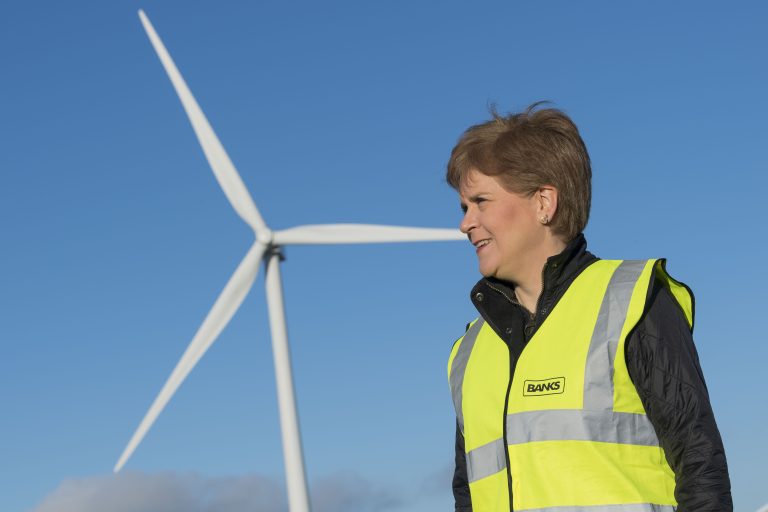Nicola Sturgeon has marked the connection of the UK’s tallest and most efficient onshore wind turbines to the national grid. The 200-metre structures are part of Banks Renewables’ Kype Muir Extension Wind Farm in South Lanarkshire that will consist of 15 new ultra-efficient turbines. Lying just south of Strathaven, Kype Muir Extension’s turbines will have an installed generation capacity of up to67.2MW of renewable electricity, providing around 53,700 households with green electricity annually[1] over its 30-year lifetime – the equivalent of taking 23,550 petrol cars off the road each year[2]. The First Minister marked the turbine connection at a key time for renewable energy in Scotland. Just a year on from Glasgow playing host to COP26, clean, green energy is high on the Scottish Government’s agenda, with onshore wind power a key player in the country’s drive towards its net zero ambitions. During her visit to Kype Muir Extension on the morning of the 16 November, the First Minister unveiled a plaque at the site, as well as having the opportunity to discuss the future of renewable energy with members of the Banks Renewables team. First Minister Nicola Sturgeon said: “Onshore wind is the biggest source of renewable energy in Scotland, making it a vital part of our mission to become a net zero economy by 2045. “In addition to being a cheap and reliable source of electricity that harnesses one of our most abundant resources, onshore wind can also help us meet that target in a way that benefits communities – through the creation of high quality jobs, and investment in local businesses and supply chains – as part of a just transition from fossil fuels to renewable energy. “The damaging impacts of the climate emergency recently highlighted at COP27 and the spike in energy prices since the war in Ukraine demonstrate the importance of accelerating that transition. Kype Muir extension is a significant example of that in action, and the Scottish Government will shortly outline how we plan to boost the country’s onshore capacity by up to 12 gigawatts by 2030, which could produce enough electricity to power 10 million homes for a year, or every home in Scotland for more than four years.” The South Lanarkshire wind farm is an extension of Banks Renewables’ 26-turbine Kype Muir Wind Farm site. The extension will feature four 156m, three 176m and eight 200m-tall wind turbines. Scottish civil engineering firm RJ McLeod (Contractors) Ltd which was originally appointed by Banks to construct the first Kype Muir wind farm has also been appointed as the contractor for the extension site. The adjacent Kype Muir wind farm and the new extension will have a combined capacity 155.4MW which will generate enough electricity for around 124,000 households each year. Banks Renewables’ existing Kype Muir site was chosen as the location for the launch of the Scottish Government’s Onshore Wind Policy consultation just last year and was praised by the Cabinet Secretary for Net Zero, Energy and Transport, Michael Matheson MSP, for its positive impact on the surrounding South Lanarkshire community. Andrew Liddell, development director at Banks Renewables said:“To welcome the First Minister to the site and have her mark such a major milestone for Scotland’s renewable energy sector is an incredible privilege and proud moment for everyone involved in the project. “Kype Muir Extension and its impressive turbines are an excellent example of a project that can make a real and positive impact towards the Scottish Government’s ambitious net-zero targets. “Not only does the wind farm have the tallest and most efficient turbines on UK land, but it will also play a key role in providing the surrounding community with major benefits – something that is high on our agenda. Over its 30-year lifetime, there is no doubt that Kype Muir Extension will prove valuable in many different ways for South Lanarkshire and Scotland as a whole.” The Kype Muir project is a flagship development for Banks Renewables and its site is where the company’s first Scottish Community Partnership, the Kype Muir Community Partnership was launched, pledging to support local projects that are charitable, educational, philanthropic or benevolent in purpose through the distribution of funding. Funding is also available for Banks’ flagship Connect2Renewables Charter to maximise the benefits of its renewable electricity developments for local people and the local economy. With the introduction of Kype Muir Extension, the Hamilton-based firm will look to reinforce and enhance the principles of community partnership originally founded at Kype Muir. Kype Muir and Kype Muir Extension are set to deliver community benefits equating to more than £700,000 per annum, with funds available to surrounding communities each year. The impressive Kype Muir Extension is set to be fully complete and producing clean, renewable electricity to the national grid in early 2023. To find out more about Banks Renewables Kype Muir Extension Wind Farm, please visit; https://www.banksgroup.co.uk/KypeMuirExtension Building, Design & Construction Magazine | The Choice of Industry Professionals







